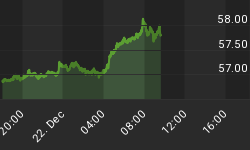Stock markets are sending out a major sell signal. Although CNBC is reporting that the Dow Jones Industrial Average (DJIA) is making new highs and investors are encouraged by the slowdown of inflation, further inspection shows that we are days away from the end of the bull market that began in 2002. Considering the positions of the other major indexes, the technical characteristics of the DJIA, and an extreme in sentiment, investors would be wise to sell their positions and preserve their assets.
First, the DJIA is making new highs without the other major indexes. The broader S&P500 is still 12% below its all time high and the NASDAQ, the usual leader, is down more than 50%. Markets that are fractured warn of weakness. Also these returns do not take into consideration the 35% fall in the US. Dollar, which since 2001 has inflated the rebound in the equity markets. So the new high in the DJIA that CNBC touts is not a true new high in actual value. Regardless of the U.S. dollar issue, other minor indexes, such as the S&P Small Cap 600, the S&P Mid Cap 400, and the Russell 2000 are also still struggling below their recent May highs.
Besides the disunity in the indexes, The DJIA's internal strength is deteriorating as well. The advance-decline line, momentum, NYSE breadth and inverted volatility indicators are all lagging the price advance. These technical indicators are behaving just as they should for the end of the rally and foreshadow another round of major selling.
Third, sentiment towards the DJIA is at extreme levels. MBH Commodities reported Friday that its Daily Sentiment Indicator, a survey determining market participant emotions recorded a 92% bullish reading. This means that only 8% of investors surveyed think the Dow will not continue to rally. This is an extremely one-sided consensus for a stock index. As contrarian investors, we are proudly in that 8% and see this as the most compelling evidence of a top. The 92% is also a tie for the record in bullishness towards the DJIA which was reported in November 2001. We all remember what followed in the markets over the next year. A more recent example of the usefulness of this indicator occurred in late April. At that time, the commodity silver recorded an almost unanimous 98% bullish reading. It is currently 23% below that high, recorded days after in early May. The DJIA's own reading in early May was 88% bullish, right before it sold off 8%. So while the market could continue to grind higher from here, marginally increasing investor optimism, history implies that it will be for a short amount of time and for a small return. The risk could be substantial in that we are ending the summer rally, as well as the rally since 2002, returning to complete the third and final phase of the bear market that started in 2000.
Our interpretation of the DJIA separating from the other indexes is that investors have been seeking blue chip defensive positions. This is reinforced by the recent strength in the Dow Jones Utilities Index. As the housing market continues to slow and drive the economy into recession, investors will find that these companies will not be immune to a fall in valuations, as in 2001-2002. Commodities, real estate, minor U.S. stock indexes and emerging markets have all peaked and are falling. We are heading towards a deflationary credit crunch, where all assets fall in value (most more than 40%). We are therefore recommending to our clients protection of principal and cash positions. To accomplish this, we are buying U.S. Treasury Bills. Our research shows that the markets will begin to feel the downward pull of the four year cycle resulting in a dramatic fall through the end of the year. Financial institutions that are holding mortgages as assets will find their portfolios valued significantly less, as the scramble for cash begins. Bankruptcies and foreclosures will increase dramatically. This should continue until valuations have bottomed, most likely in 2010. Like the market cheerleading in 2000, CNBC and the rest of the financial media's reporting of the DJIA's new high is actually the peak in optimism for this cycle and the beginning of a new downtrend.















